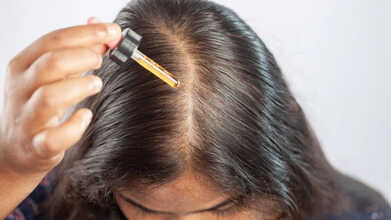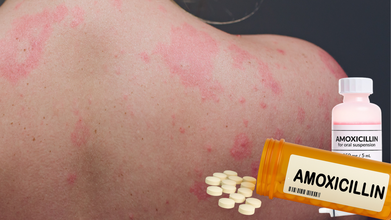- Health Conditions A-Z
- Health & Wellness
- Nutrition
- Fitness
- Health News
- Ayurveda
- Videos
- Medicine A-Z
- Parenting
You May 'Not Have A Nerve' , But Scientists Just Found You Do Have A 'Second Heart' To Pump Blood

When we hear the word "heart," we imagine the body's engine—a tireless, muscular pump that works to circulate blood and bring oxygen to every living cell. But in a shocking discovery, scientists now suggest that we might have been underestimating another silent hero of our cardiovascular system- the aorta. Long considered to be little more than a passive pipe, the aorta is now being recognized as an active, dynamic participant in supporting the heart—so much so that scientists are referring to it as a "second heart."
This revolutionary finding presents a promising new vision of cardiovascular function and may redefine the way we treat heart failure and circulatory health globally.
The aorta, the largest artery in the human body, has long been renowned for its elasticity—stretching to allow the surge of blood from the heart and recoiling to keep pressure constant. Though these qualities were once thought to be purely passive, new studies published in The Journal of The Royal Society Interface show a more active role.
The aorta also does more than merely absorb pressure, according to research. The aorta produces what's referred to as a "wave-pumping effect"—a mechanical function by which the vessel stretches and recoils in harmony with the cardiac cycle. This motion generates energy that helps push blood through the body, essentially serving as a second pumping mechanism.
This phenomenon, only seen before in the initial stage of embryonic development, seems to continue up to adulthood, particularly being important in patients whose heart function is impaired.
How Your Aorta Becomes a "Second Heart"?
The wave-pumping mechanism, scientifically known as impedance pumping, is the interaction between heartbeats and the elasticity of the aorta. As the heart contracts during systole, the left ventricle forces blood into the aorta, stretching it like a spring. Subsequently, during diastole when the heart relaxes, the aorta snaps back, propelling the blood forward using stored mechanical energy.
This back-and-forth stretch-recoil mechanism enhances circulation without demanding another heartbeat. It's nature's clever technique for lessening cardiac burden while preserving blood flow—and might be particularly critical when the heart has been compromised by disease.
Researchers employed magnetic resonance imaging (MRI) to study the motion of the aorta of 159 people, both healthy volunteers and those with heart failure. The findings were dramatic.
Healthy subjects demonstrated much greater aortic displacement, reflecting strong wave-pumping activity. Conversely, individuals with heart failure had lower aortic stretch, implying weaker secondary pumping assistance. This contrast illuminates how some individuals with compromised hearts are able to pump blood efficiently anyway—partly due to the mechanical aid of their aorta.
Can Your Aorta Help Save Your Heart?
Heart failure, which impairs the heart's pumping ability, affects millions worldwide. This discovery paves the way for an entirely new treatment category: increasing the elasticity of the aorta to facilitate blood flow.
Today, certain antihypertensive medications are attempting to decrease arterial stiffness, but their specific effect on aortic wave-pumping is unknown. With this new understanding, therapies in the future may be created to activate or restore the aorta's pumping ability, relieving the failing heart's workload and enhancing patient outcomes.
Researchers are also examining non-drug treatments such as lifestyle changes and exercise, both of which are known to enhance vascular flexibility. Might we one day have individualized exercise regimens or vascular therapies specifically designed to maximize this second heart? The potential is intriguing.
Why the Aorta's Role Was Overlooked?
Interestingly, the wave-pumping function of the aorta was heretofore seen only during the embryonic stages, where it helped still-undeveloped hearts pump blood. Gradually, as the heart developed, researchers presumed that this process became obsolete.
That turns out not to be the case, according to this new study. What turns out to be true is that the aorta can continue to have this function deep into adulthood, particularly kicking in during cardiac duress.
This discovery is a paradigm shift in our conception of the vascular system—not only as a tube network, but as a smart, adaptive circulation partner.
To comprehend the aorta as something greater than an inert pipe—but instead as a second heart—may revolutionize diagnostics and treatment approaches for cardiovascular disease. From how we read MRI scans to how we customize therapies for heart failure patients, this information introduces a new dimension of complexity—and hope.
In the future, keeping your heart healthy might also mean taking better care of your aorta—the silent force that could be saving your life, one beat at a time.
Cold Or Flu? NHS Reveals 3 Symptoms To Spot The Difference

Credits: Canva
Catching a cold during winter is fairly common because viruses spread more easily in packed indoor settings, and cold weather can weaken the immune defence inside the nose, making it harder to fight infections. Having a stuffy nose or a mild cough is one thing, but many people often confuse their illness with a cold when it may actually be flu. Flu symptoms are usually more intense and can include fever, headaches and body aches, along with a dry cough and sore throat. A cold, on the other hand, tends to peak within two to three days, with recovery usually taking about a week.
Cold vs Flu: Why Knowing the Difference Matters
With a strong flu strain causing disruption across the UK, knowing how to tell the difference between a cold and flu has become especially important. Berkshire NHS, which has around 17,100 followers on TikTok, has outlined three key differences between the two illnesses.
In a caption, the community NHS trust said: “Cold and flu symptoms can look similar, but flu is usually more severe. The flu vaccine helps protect against flu. Visit the NHS website to learn more.”
NHS Shares 3 Symptoms to Tell Cold and Flu Apart
The video features an NHS staff member pointing out three signs as she walks toward the correct option. The first is that flu comes on suddenly, often within a few hours, while a cold mainly affects the nose and throat. The final sign is that flu can leave you feeling drained and too unwell to go about your normal routine.
Can Flu Get Better on Its Own?
Flu often clears up on its own, but it can make some people very unwell. That is why it is important to get vaccinated if you are advised to do so and to follow safe distancing to reduce the spread of infection.
Flu Symptoms 2025
As per NHS, below are the flu symptoms that people need to take care of:
- A sudden high temperature
- An aching body
- Feeling tired or exhausted
- A dry cough
- A sore throat
- A headache
- Difficulty sleeping
- Loss of appetite
- Diarrhoea or tummy pain
- Feeling sick and being sick
What Are The Symptoms Of A Cold?
- A blocked or runny nose
- Sneezing
- A sore throat
- A hoarse voice
- A cough
- Feeling tired and unwell
- A high temperature
- Aching muscles
- A loss of taste and smell
- A feeling of pressure in your ears and face
How Long Does a Cold Last?
In most cases, a cold can be managed at home without seeing a GP. You should start to feel better within one to two weeks, with symptoms developing over two to three days.
Cold Symptoms in Children: What Parents Should Know
Cold symptoms can last longer in young children. They may become more irritable, struggle with eating and sleeping, breathe through their mouth, and sometimes vomit after coughing. As per NHS, try to get enough rest over the Christmas holidays if possible, drink plenty of fluids, and eat nourishing food to help lower the risk of illness.
Minoxidil Use By Mothers Linked To Potential Health Risks In Infants

Credits: Canva
Mothers who use minoxidil, a widely used hair loss treatment, may increase the risk of infantile hypertrichosis in babies, a condition marked by excessive hair growth across the body, including areas where hair does not usually grow, according to a large international analysis.
Minoxidil Use by Mothers Linked To Potential Health Risks In Infants
Researchers from the Ministry of Health and Family Welfare and the All India Institute of Medical Sciences (AIIMS), New Delhi, reviewed 2,664 worldwide reports of suspected infantile hypertrichosis linked to minoxidil. Of these, 45 cases involved children aged between birth and 23 months.
The analysis showed that 22.2 per cent of these infant cases were associated with maternal exposure to minoxidil. Accidental exposure accounted for 44.4 per cent, while the cause remained unclear in 33.3 per cent of cases. The findings were published in the Archives of Dermatological Research.
What Is Minoxidil?
Minoxidil is a drug most commonly used to treat pattern hair loss, known as androgenetic alopecia, in both men and women. In higher oral doses, it is also prescribed for severe high blood pressure. The medicine works as a vasodilator, meaning it helps widen blood vessels to improve blood flow.
What Is Infantile Hypertrichosis?
Infantile hypertrichosis (also called childhood hypertrichosis or werewolf syndrome) is a rare condition marked by excessive hair growth on the face, back, arms, and other areas, appearing from infancy, often with a genetic cause but sometimes triggered by medications (like minoxidil) or underlying conditions, leading to significant cosmetic and psychological distress despite being a generally harmless cosmetic issue
Minoxidil: Eye-Related Side Effects Also Reported
The study also highlighted concerns beyond infant cases. Researchers identified 1,669 global reports of eye-related adverse effects linked to minoxidil use in the general population, including 25 cases reported from India.
Commonly reported eye symptoms included swelling of the eyelids, blurred vision, and central serous chorioretinopathy, a condition in which fluid accumulates beneath the retina and can affect eyesight.
Background on Minoxidil
Minoxidil was originally developed to treat high blood pressure. It was later reformulated as a topical treatment for hair loss in both men and women after its hair growth–stimulating side effects were observed. The drug is typically applied directly to the scalp or affected skin areas, the researchers noted.
Minoxidil: Concerns Over Regulation and Use
Despite its proven effectiveness, the researchers raised concerns about the drug’s widespread over-the-counter availability and limited regulatory oversight. These factors, they said, increase the risk of misuse and unintended exposure.
Although minoxidil is generally advised against for use during pregnancy and breastfeeding, the analysis still identified cases of infantile hypertrichosis linked to maternal exposure during these periods.
The researchers noted that minoxidil has also been associated with eye-related side effects in the broader population, prompting renewed questions about its overall safety profile.
“This study aims to examine global reports of infantile hypertrichosis associated with maternal minoxidil exposure and to assess serious and non-serious eye disorder cases reported in India, with the aim of improving awareness about the risks of early-life or accidental exposure,” the authors wrote.
The study was based on data collected up to March 2025 from VigiBase, the World Health Organization’s global database of suspected adverse drug reactions.
What To Do When Amoxicillin Gives You Rashes?

Credits: iStock
This year had been a year of flu, fiver, bacterial illness and more. One of the over the counter medicine that many people often buy, or is prescribed, especially for bacterial infections is Amoxicillin.
What Is Amoxicillin?
It is a widely prescribed antibiotic that is used to treat bacterial infections in children and adults. It is part of the penicillin class of medications and it inhibits the growth of bacteria and allows the immune system to efficiently eliminate the infection. It is commonly used to treat bacterial infections affecting the respiratory tract, urinary tract, and skin.
However, about 5 to 10 per cent of children prescribed this may develop skin rashes as a common side effect. A rash can develop in two forms: allergic and non-allergic. A rash from the drug Amoxicillin could last up to a week.
What Kind Of Rashes Are Caused By Amoxicillin?
A Maculopapular rash is a flat rash that occurs like red patches, raised bumps and spreads over the body.
Hives are itchy, raised red or skin-colored welts that can change shape and location.
Erythema Multiforme are more severe, featuring target-like lesions or bull's-eye shapes with central red spot, pale ring, and red outer ring.
Anaphylactic Reaction is a rare but severe allergic reaction that includes symptoms like difficulty in breathing, swelling of the face, lips, or tongue, hives and rapid drop in blood pressure.
Non-Allergic Amoxicillin Rash are flat, red spots that may be slightly raised, but not harmful. These usually appear o the 5th to 7th day after the start of amoxicillin and can appear on the chest, abdomen, back, face, arms, and legs. It may get worse before it starts to get better.
What Signs Should You Look Out For?
Warning signs include rashes within two hours of the first amoxicillin dose, difficulty breathing or swallowing, or very itchy hives.
The allergic reaction is caused by one's immune system reacting to that medication as if it were a foreign invader in the body.
More girls than boys develop these rashes, and in children this is even more common. In fact, the rash by amoxicillin was first noted in 1960s, in children who were being treated with ampicillin, recorded the Journal of Pediatrics.
What Can You Do If You Get Amoxicillin Rashes?
Among treatment, the first step should be to see your physician and immediately stop taking the medication. Drinking water and enough fluids can also help. Your doctor too would prescribe you medications and lotions to soothe your itching.
Hives can also be treated with the over the counter drug Benadryl. However, you must go see your doctor or GP, and not self medicate.
A doctor may treat the rash in various ways, including stopping the medication as the first line of defense. Then the doctor may give oral antihistamines (e.g., cetirizine) for the itch. Some doctors may use topical steroids to help with the itch and redness.
Before visiting your doctor, take photos of your rash, send it to your GP, as if it is contagious. Even after you start the treatment, stay in touch with your healthcare provider for any development.
© 2024 Bennett, Coleman & Company Limited

